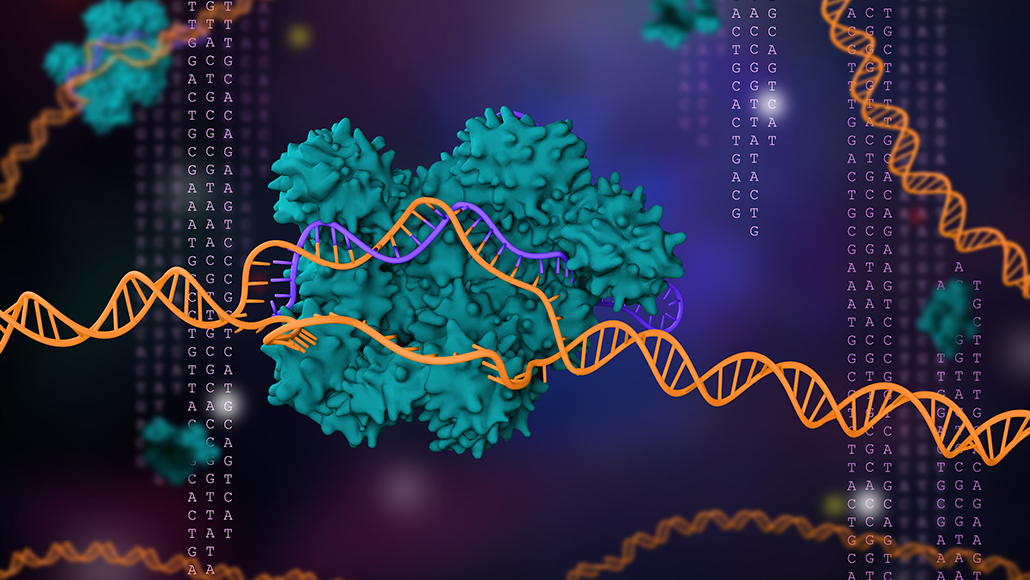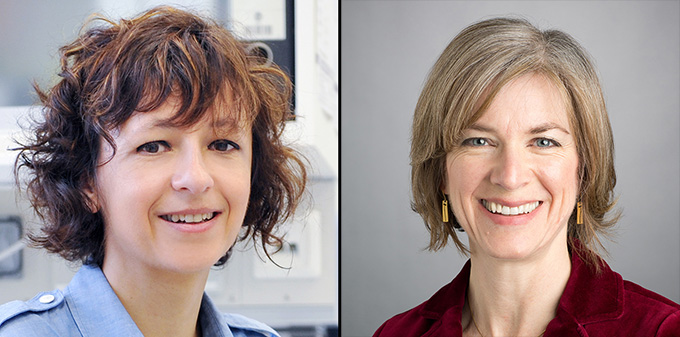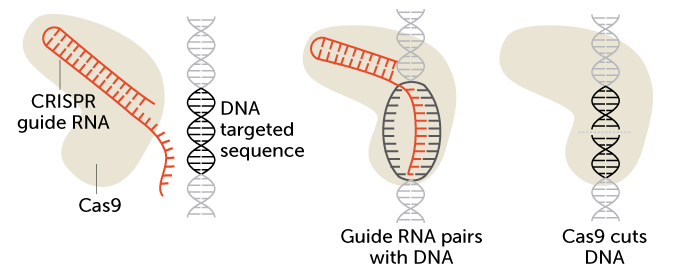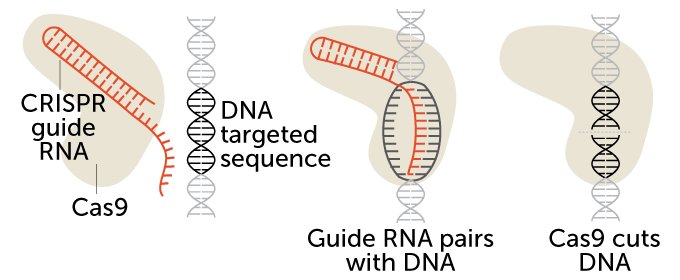
Researchers Emmanuelle Charpentier and Jennifer Doudna devised a powerful gene-editing tool called CRISPR/Cas9 (illustrated). The gene editor has revolutionized molecular genetics and gene therapy and netted the duo the 2020 Nobel Prize in chemistry.
Meletios Verras/iStock/Getty Images Plus
Turning a bacterial defense mechanism into one of the most powerful tools in genetics has earned Jennifer Doudna and Emmanuelle Charpentier the Nobel Prize in chemistry.
The award for these genetic scissors, called CRISPR/Cas 9, is “a fantastic prize,” Pernilla Wittung-Stafshede, a member of the Nobel Committee for Chemistry, said at an Oct. 7 news conference held in Stockholm by the Royal Swedish Academy of Sciences to announce the prize. “The ability to cut the DNA where you want has revolutionized the life sciences. We can now easily edit genomes as desired — something that before was hard, or even impossible.”
“The genetic scissors were discovered just eight years ago, but have already benefited humankind greatly,” she said. “Only imagination sets the limits for what this chemical tool … can be used for in the future. Perhaps the dream of curing genetic diseases will come true.” She later amended the statement to say that ethics and law are also important to determine what can and should be done with the tool, as some human gene editing is extremely controversial.
Only five other women have ever won the Nobel Prize in chemistry. “I wish that this would provide a positive message specifically to the young … girls who would like to follow the path of science, and I think to show them that women in science can also be awarded prizes, but more importantly that women in science can also have an impact through the research that they are performing,” Charpentier said in response to a question during the news conference.
The two will split prize money of 10 million Swedish kronor, about $1.1 million.

The tool, a programmable molecular scissors known as CRISPR/Cas9, has been used by bacteria and archaea for millions to billions of years to fight viruses (SN: 4/5/17).
CRISPR stands for Clustered Regularly Interspaced Short Palindromic Repeats. In essence, these short, repeating bits of DNA sandwich bacteria’s version of the FBI’s most wanted list — invading viruses. Every time bacteria encounter a virus, they take a DNA mug shot of it and file it in between the repeats. The next time the bacteria encounters that virus, they make RNA copies of the mug shots. Those RNA photocopies then team up with another bit of RNA known as a trans-activating CRISPR RNA, or tracrRNA, to form an all-points bulletin known as a guide RNA. Guide RNAs shepherd the DNA-cutting enzyme Cas9 to the virus, where the enzyme chops and eliminates the threat.
Doudna of the University of California, Berkeley, and Charpentier, now director of the Max Planck Institute for Infection Biology in Berlin, met in 2011 at a conference in Puerto Rico. “We walked around Old San Juan and talked about CRISPR/Cas9,” Doudna recalled during a virtual news conference October 7. The scientists decided to team up to study the bacterial defense system and ended up turning it into a gene editor. Their innovation was to fuse the mug shot RNA to the tracrRNA, creating a single guide RNA. And the researchers realized that the mugshots didn’t have to be molecular pictures of viruses. Instead, by replacing the mug shot with RNA that matches a gene, the scientists could direct Cas9 to snip that gene — or any gene, really.
Molecular scissors
CRISPR/Cas9 is a two-part gene editing tool made up of a guide RNA and an enzyme, Cas 9, that cuts DNA. A guide RNA brings the enzyme to a particular spot in an organism’s DNA that researchers wish to cut (the targeted sequence in this diagram). The spot is a chemical match for the RNA. Once ferried to the right spot, Cas9 snips the DNA.
How CRISPR/Cas9 works


“The seminal paper they published together has been cited more than 9,500 times — approximately once every eight hours since its publication in 2012,” says David Liu, a chemical biologist and Howard Hughes Medical Institute investigator at Harvard University. Liu and others have altered the original CRISPR system so that researchers can use it in a variety of ways.
The win was “extremely highly anticipated. I think everyone has been talking about CRISPR [as a Nobel contender] for a long time now,” says Luis Echegoyen, a chemist at the University of Texas at El Paso and president of the American Chemical Society. Even though the gestation period from discovery to Nobel Prize is typically much longer, the award for CRISPR is “long overdue,” says Echegoyen.
CRISPR’s promise was immediately apparent, says Stanley Qi, a bioengineer and biotechnologist at Stanford University. As a student in Doudna’s lab, Qi had a ringside seat to the discovery and knew then that CRISPR would do great things. “In these eight years there have been so many breakthroughs and advances,” he says, “it’s far beyond my expectations.”
Doudna and Charpentier “have continued to look at the broad category of CRISPR” enzymes, Qi says. Their ongoing work has contributed new insight into the evolution and the mechanisms behind how the bacterial system works. Doudna’s work to define the structure and function of the Cas9 enzyme laid the groundwork for improving the accuracy and efficiency of gene editing, he says.
Many researchers have now taken these genetic scissors to the next step, using CRISPR/Cas9 to cut and edit genes in human cells. Scientists rave about how cheap, versatile and easy to use CRISPR is. Researchers have used it edit genes in a wide variety of animals, including dogs (SN: 8/30/18), mice (SN: 1/26/17), butterflies (SN: 8/24/16), cows (SN: 2/3/17), pigs (SN: 8/10/17), snails (SN: 5/14/19) and mosquitoes.
The tool has also been used to encode data and store movies in bacterial DNA (SN: 7/12/17). Plants and mushrooms have gotten the CRISPR treatment, too. And the gene editor has been used to reprogram human immune cells to fight cancer (SN: 11/16/16) and to turn cancer cells against each other (SN: 7/11/18).
With CRISPR’s great power comes great controversy, Doudna warned in her 2017 book A Crack in Creation with coauthor Samuel Sternberg. While the gene editor might be used to stamp out invasive species and prevent mosquitoes from carrying disease, it might also drive entire species extinct or create ecological disasters. Already scientists have wiped out small populations of mosquitoes in the laboratory using a CRISPR-based molecular copy machine known as a gene drive (SN: 9/24/18).
Sign up for our newsletter
We summarize the week's scientific breakthroughs every Thursday.
Most controversially, a scientist in China edited genes in human embryos, producing twin baby girls in 2018 (SN: 11/28/18). Backlash against his actions was swift and vocal. But many people fear the door is already open to “designer babies,” health care inequalities and other abuses (SN: 12/17/18).
“This enormous power of this technology means that we need to use it with great care,” Claes Gustafsson, chair of the Nobel Committee for Chemistry, said at the news conference. “But it’s equally clear that this is a technology… that will provide humankind with great opportunities.”
More hopefully, clinical trials testing CRISPR/Cas9’s ability to treat cancer, sickle cell disease, beta-thalassemia and inherited blindness began in 2019 (SN: 8/14/19). If successful, CRISPR/Cas9 may provide therapies, or even cures, for previously untreatable genetic conditions.
CRISPR has also played a role in the coronavirus pandemic, with CRISPR-based diagnostic tests for COVID-19 (SN: 8/31/20) and therapies in development.
When Charpentier received the news that she was a newly minted Nobel laureate, “I was very emotional,” she said at a news conference in Berlin following the announcement. “It’s one thing to be told multiple times that maybe one day you will be awarded the Nobel Prize, but another thing when it happens.”
Charpentier hopes the award will provide a message to the public “that fundamental research is critical.” CRISPR/Cas9 is a “perfect example of a discovery that has a large impact in life sciences, in research and development, but also in biotechnology and the production of food, in medicine,” she said. “That is really originating from pure, fundamental research — going very deeply in the mechanisms of life.”
Their work, “belies the notion that basic and applied research occupy different realms of knowledge,” Douglas Clark, dean of Berkeley’s College of Chemistry said in Doudna’s news conference. They “are woven together, much like DNA is.”
Doudna said she learned of her win when a reporter called to ask for comment. She is the first woman faculty member to win the Nobel Prize in UC Berkeley’s 150 year history, noted Carol Christ, the university’s chancellor. (Christ also bestowed Berkeley’s most coveted award, a free parking space on campus.) Doudna and Charpentier are the only women to share the chemistry award. “I’m proud of my gender,” Doudna declared when asked about the significance of the firsts. “I think for many women there’s a feeling that their work will never be recognized as it might be if they were a man. I want to see that change, and I certainly hope this is a step in the right direction.”
Nearly all scientific prizes for CRISPR/Cas9 have honored Doudna and Charpentier. Some prizes have also included Feng Zhang of the Broad Institute of MIT and Harvard, which holds the patent on using the gene editor to make changes in eukaryotic cells, including human and animal cells. Patent rights have been disputed by Doudna’s and Charpentier’s institutions. Many people thought that the prize would not honor work on CRISPR until the patent dispute was settled. (Zhang is a member of the board of trustees for the Society for Science & the Public, an educational nonprofit in Washington, D.C., that also publishes Science News. He is also an alumnus of the Society’s Regeneron Science Talent Search.)
Two other scientists, Rodolphe Barrangou of North Carolina State University in Raleigh and Philippe Horvath of DuPont Nutrition & Biosciences in Dangé-Saint-Romain, France, have also been honored for discoveries related to CRISPR. The duo discovered CRISPR’s natural role as a bacterial immune system while working with yogurt bacteria at the food ingredient company Danisco.
And two major prizes — the Warren Alpert Foundation prize and the Kavli prize for neuroscience — have honored Virginijus Šikšnys, a biochemist at Vilnius University in Lithuania. Šikšnys authored an independent paper describing the same innovation made by Doudna and Charpentier that was held up in the publishing process, and didn’t hit presses until three months after the UC Berkeley team’s report.
When asked if other scientists had been considered for the prize, Gustaffson said, “this is a question we never answer. We are just extremely happy for this year’s laureates. It’s a big field, and there’s a lot of good science being done.”
Staff writer Maria Temming contributed to this story.






